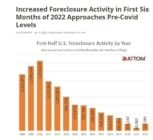
Almost 2 million homeowners were 90 days late with their mortgages in June, according to this National Mortgage News article.
But at the same time, actual foreclosure inventory was down significantly year over year.
The obvious reason behind the very low foreclosure rates, despite our economic woes, is the COVID-19-related foreclosure moratorium and the related stimulus.
THE OTHER REASON: EQUITY
But there is another huge reason why we are not and have not been seeing more foreclosures: people have equity.
One of the biggest myths relating to the 2008 mortgage meltdown was that people walked away from their homes because they could not afford their higher payments after their variable-rate mortgages adjusted higher.
That was, however, usually not the case.
Yes, there were many borrowers who could not make their payments during the post-meltdown recession and had to let their properties go.
But, many borrowers simply walked because they were upside down in their properties and did not want to continue to make payments because they did not think the market would come back.
I saw numerous very strong borrowers let their properties go – even though they could have easily kept making payments.
When homeowners have a large chunk of equity to protect, they will go to the ends of the earth to dredge up payments in order to keep their home out of foreclosure.
ADDITIONAL REASONS WHY WE ARE NOT SEEING MORE FORECLOSURES
Here are two more reasons why we are likely not going to see a lot more foreclosures, at least in the near term: (1) stronger lending guidelines; and (2) a very hot market with record-low inventories.
I have repeated these reasons over and over too. But, because there have been no “low down payment/stated income” loans made for over ten years, the loans that remain in place are much stronger now.
In addition, because most markets are so hot with inventory at record lows, people in financial trouble are able to sell their homes very quickly (unlike in 2008 when inventories were at all-time record-highs and demographic demand was at a low).
CAN THINGS CHANGE?
Things can and will change if the COVID-19 crisis and our current economic woes do not come to an end and/or if the onslaught of government aid and foreclosure moratoriums is not renewed.
If things get bad enough, the supply and demand equilibrium could change quickly (many more houses will come to market while many buyers pull out of the market), putting significant downward pressure on house prices.
I don’t see things getting as bad as 2008 though b/c we are not starting out with nearly as much excess inventory and because our demographic trends (household formations) are so much stronger.
WATCHING DELINQUENCIES
There are many reasons to keep an eye on mortgage delinquencies, as they are great indicators of the strength of the housing market and the economy overall.
Another reason has to do with the potential sellers.
According to the predictive analytics company we work with, Revaluate, borrowers with a mortgage default have a 52% chance of selling over the next 12 months.
Jay Voorhees
Founder/Broker | JVM Lending
(855) 855-4491 | DRE# 1197176, NMLS# 310167






